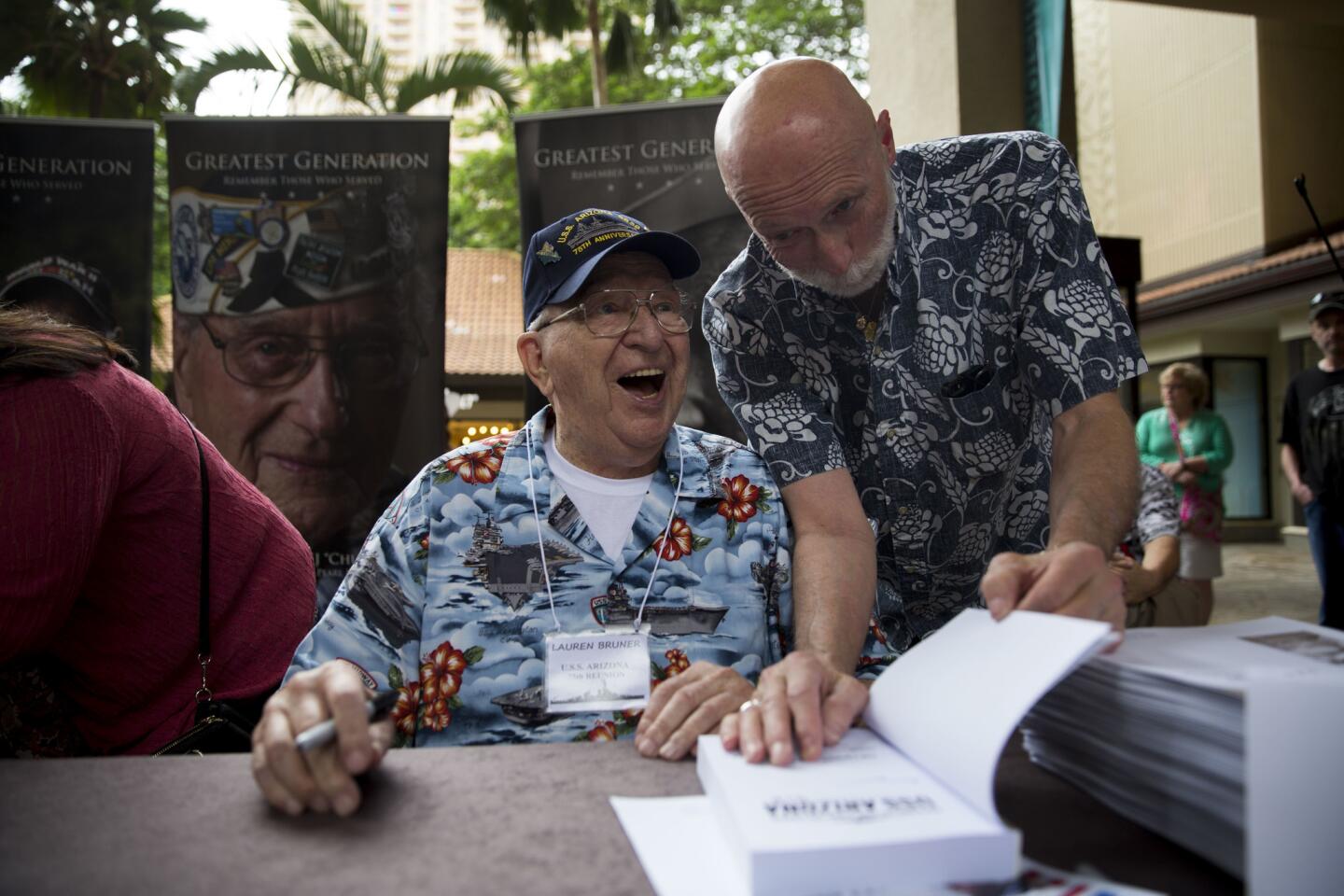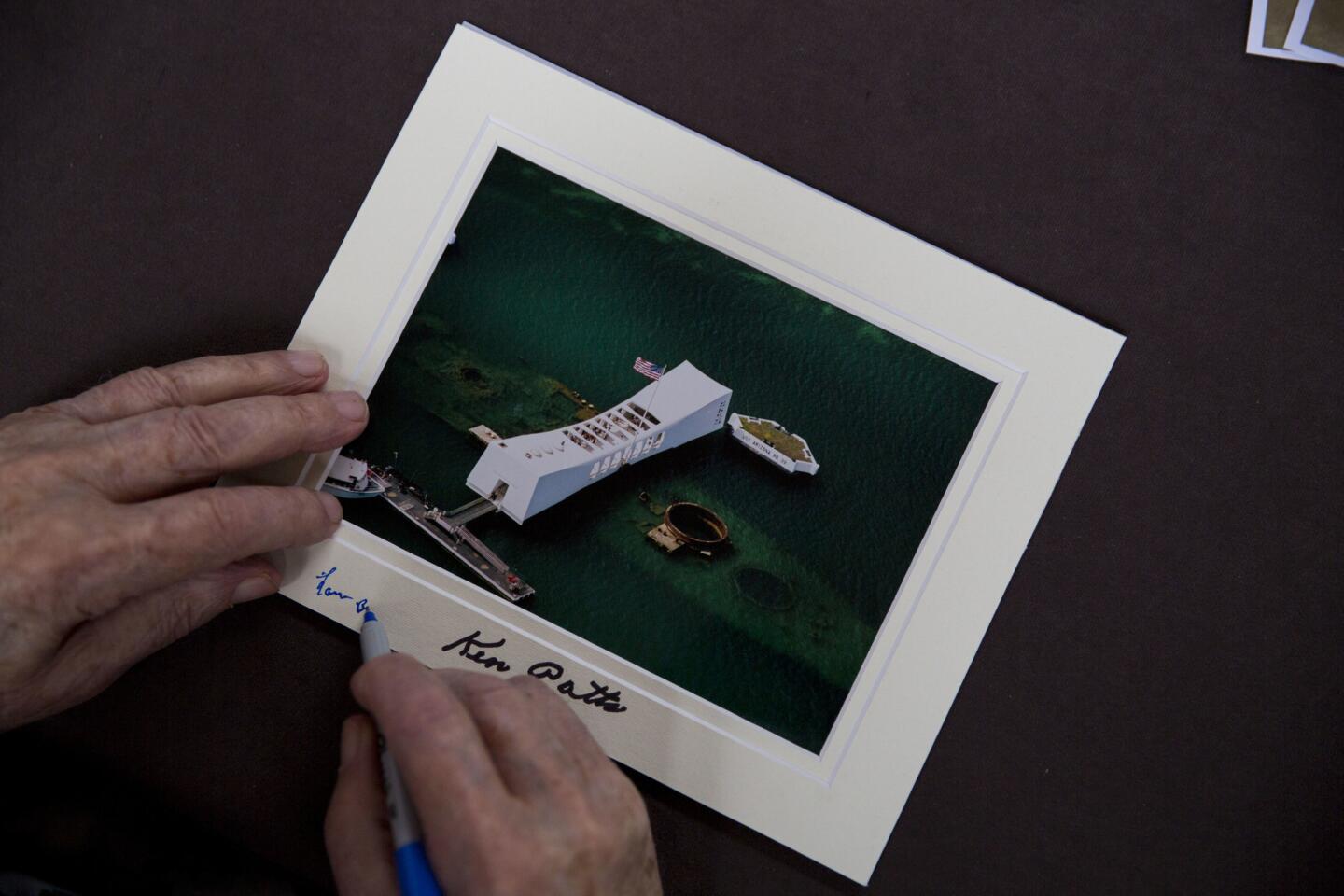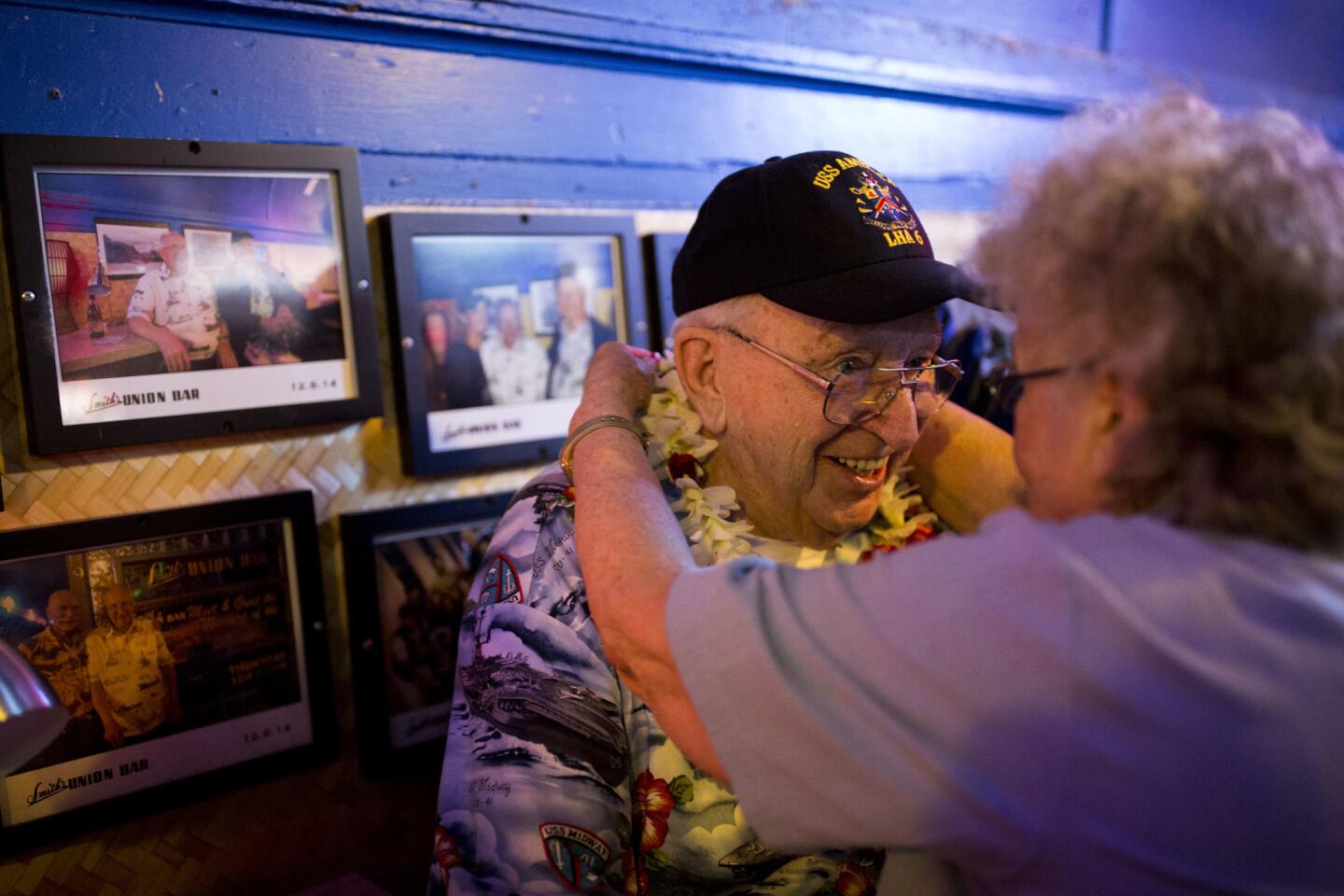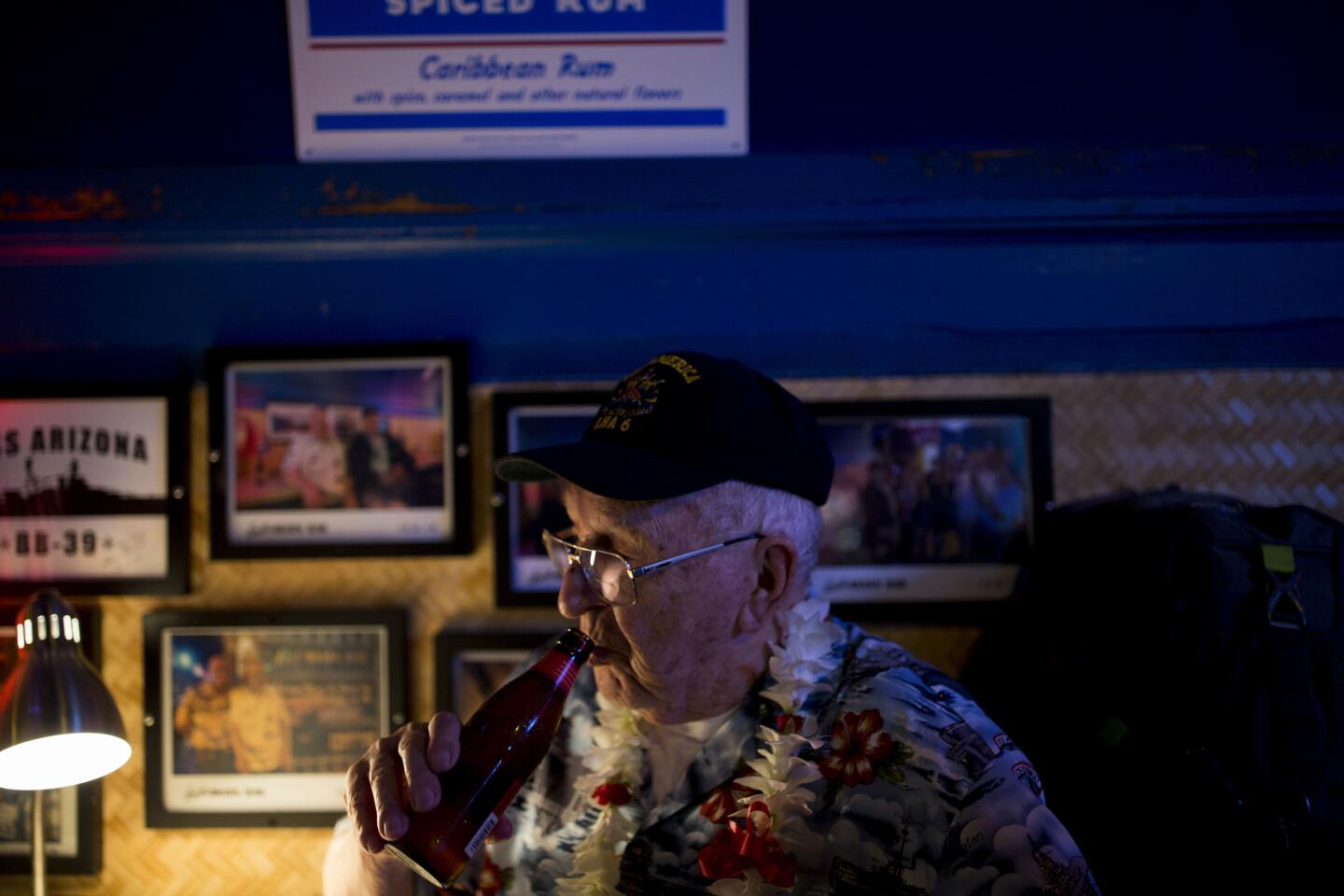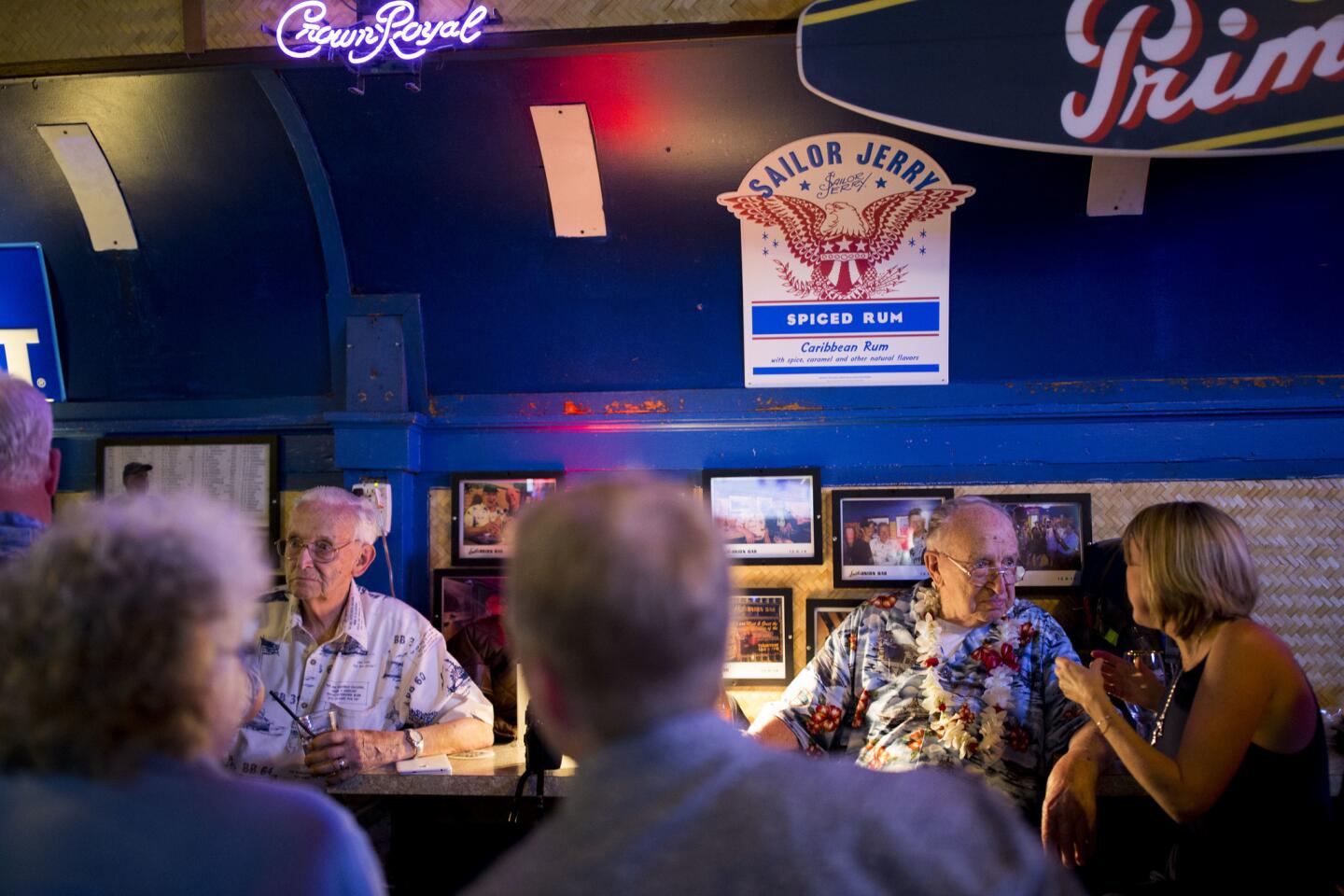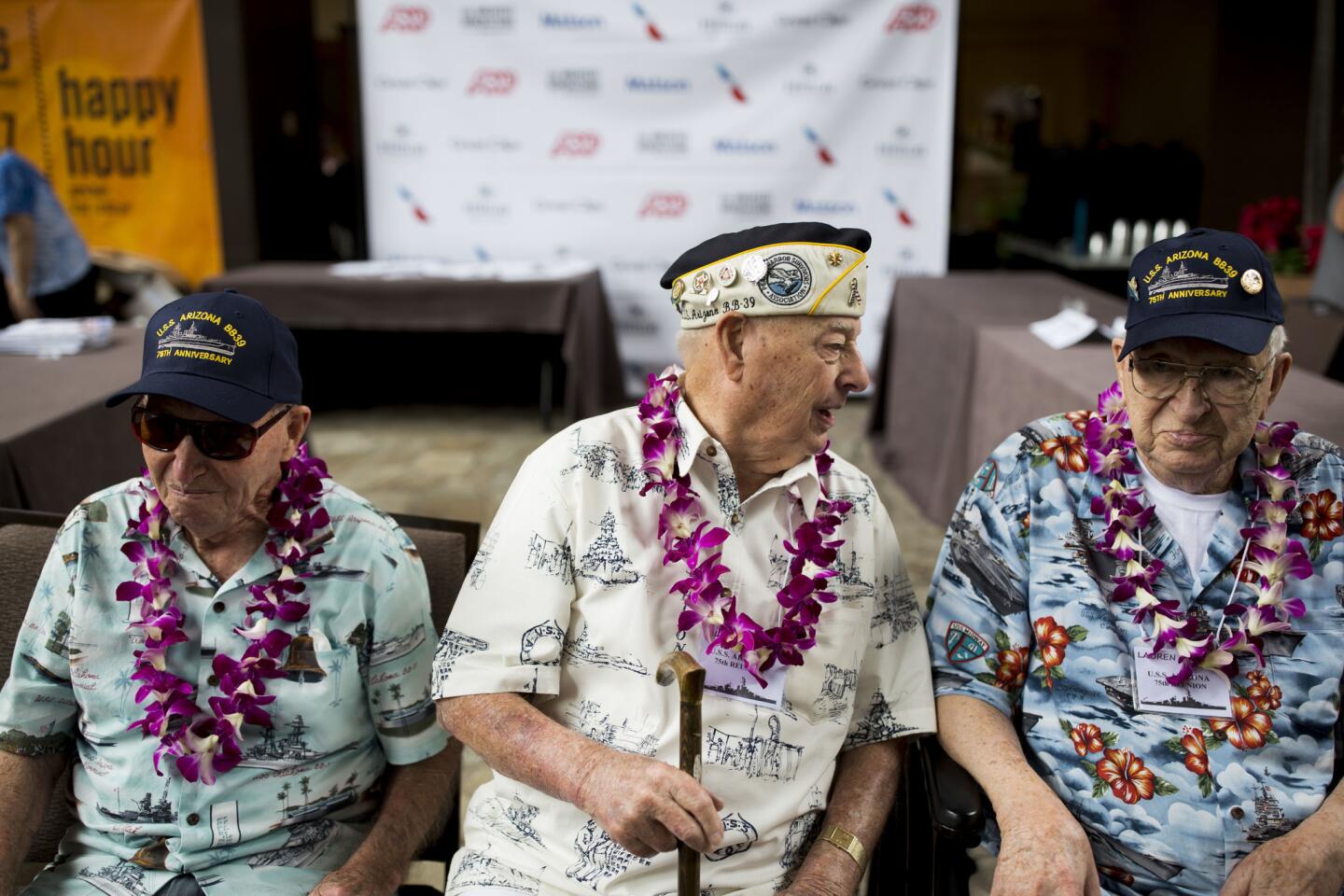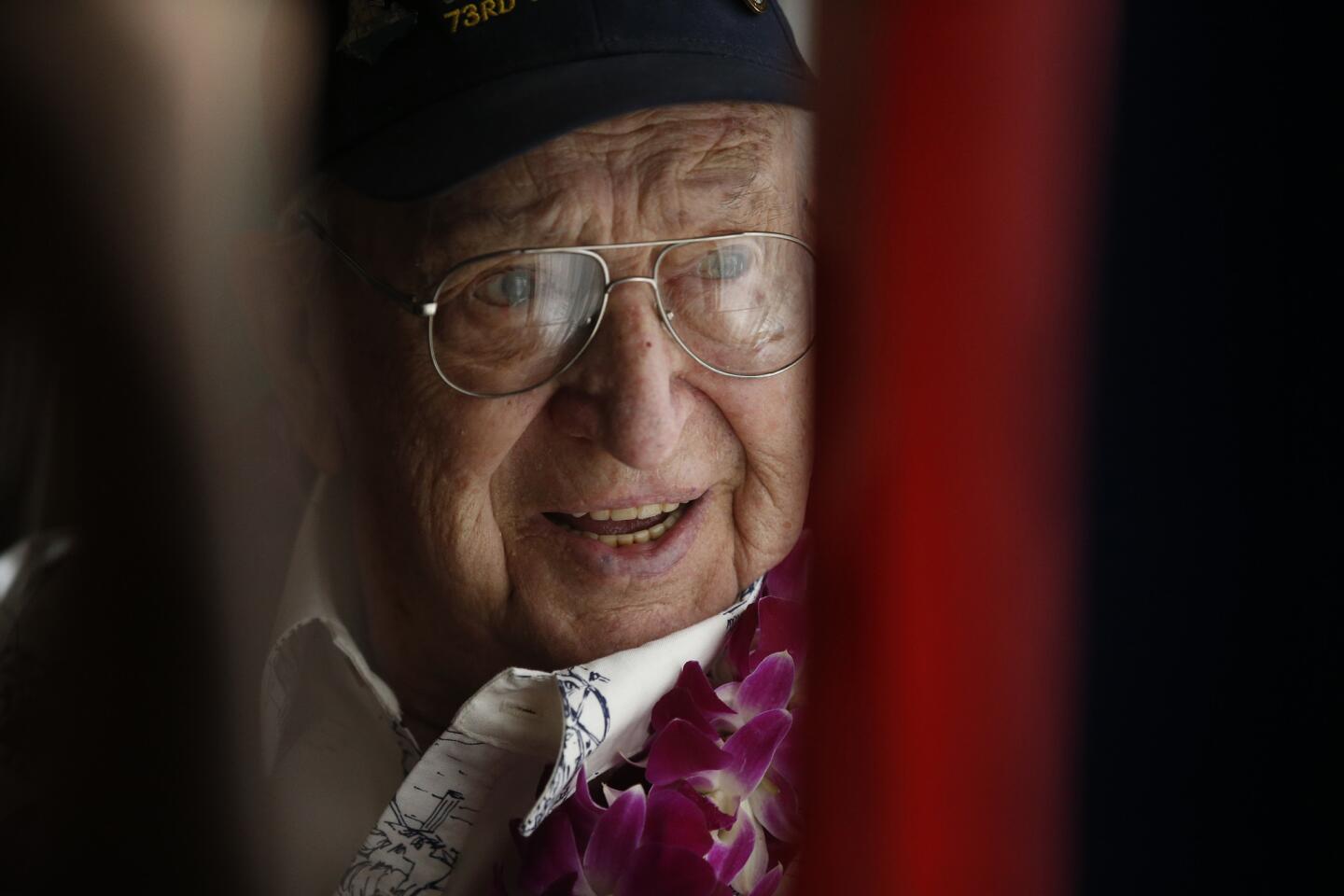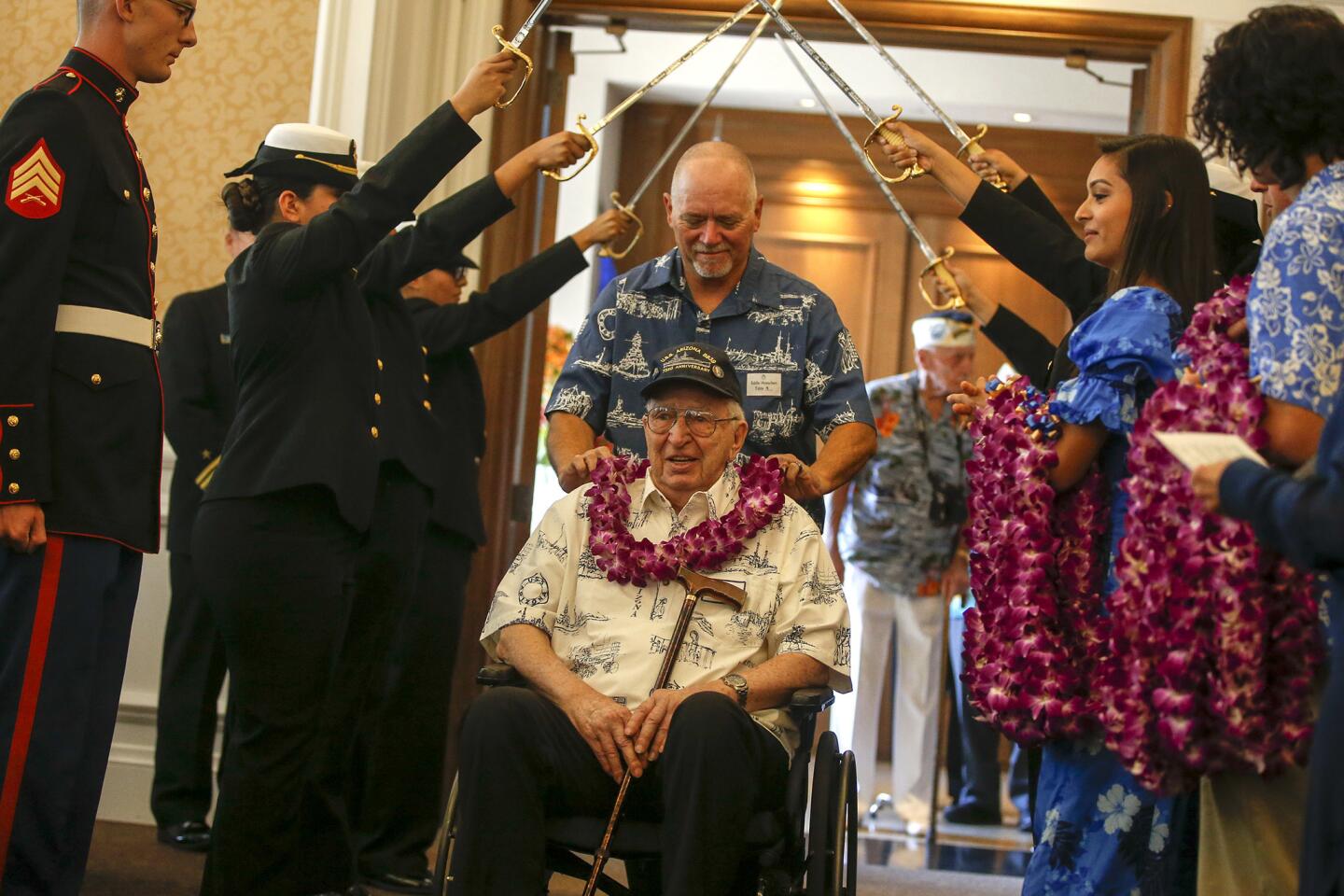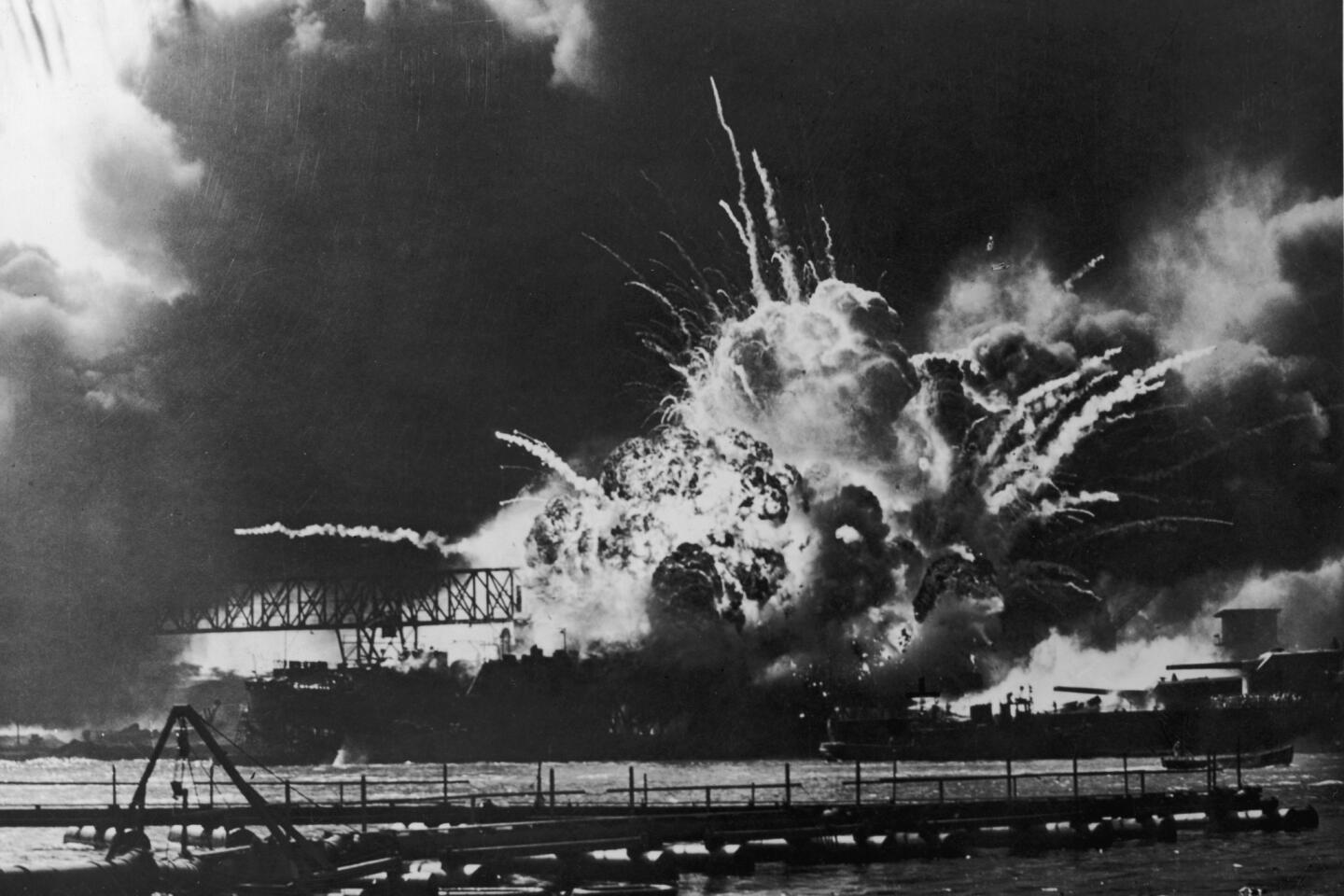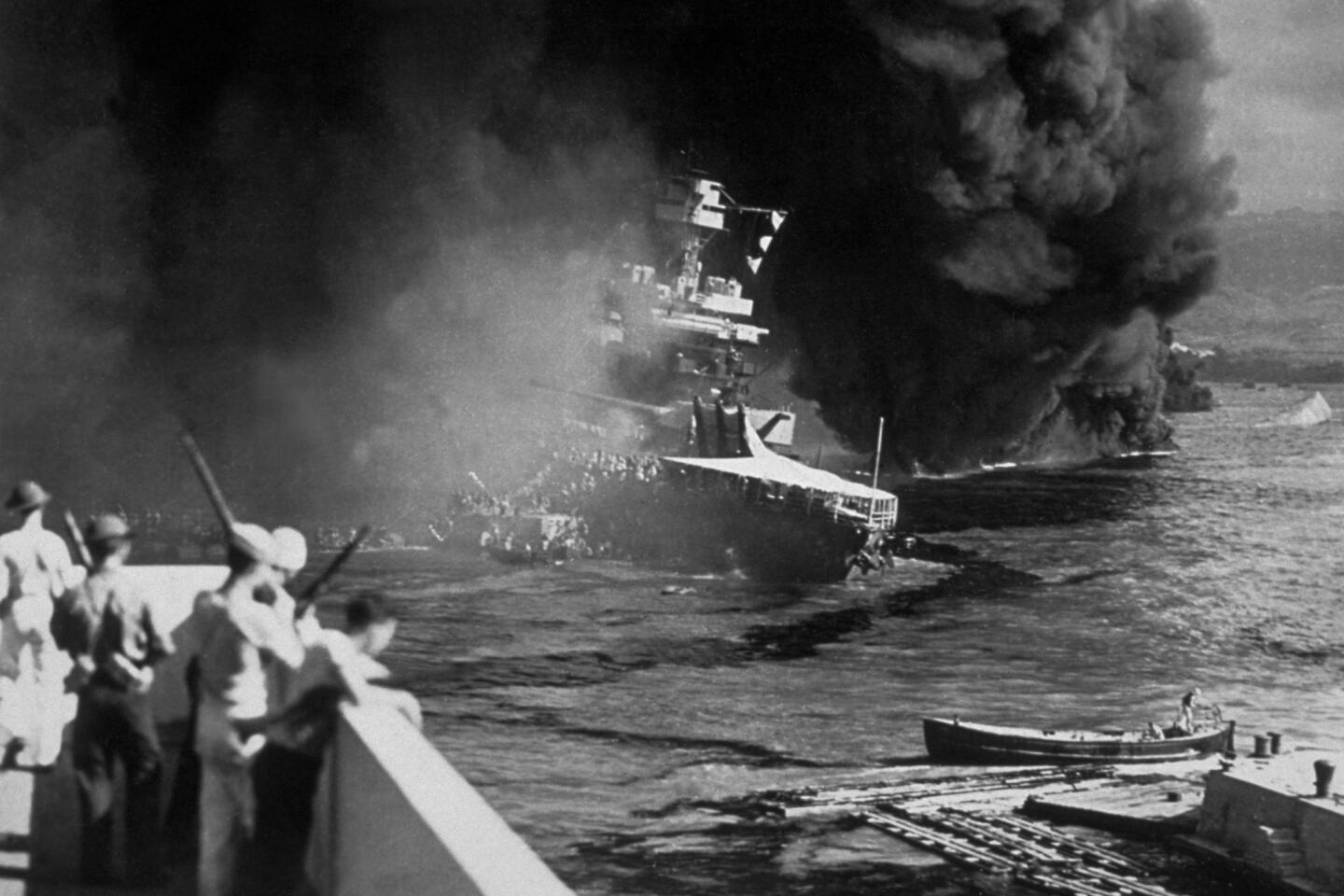A Pearl Harbor survivor spent decades trying to forget it. Then one man got him talking

On the anniversary of the attack on Pearl Harbor, survivors recall where they were and how they survived.
Reporting from Honolulu — He walked slowly, an entourage of help ensuring he didn’t slip. People in the bar clapped as he moved past. Then Lauren Bruner gave up his cane and settled at a table against the wall where his picture had been hanging for years.
Dwight Lockwood, reed-thin in shorts and flip-flops, darted behind the bar and quickly popped the cap off a Kona Longboard beer. “It’s his favorite,” he said. The drink was on the house, of course.
Bruner took a swig. Around him, dozens of people waited to shake his hand, share a story or take a picture. The bar was a dive, barely more than the width of a long hallway. He looked around from the stool — his stool — and the decades began to melt away.
No longer was he 96, with a broken heart and a busted back. He was back in Smith’s Union Bar, and it was in the exact same place it had been when he was stationed at Pearl Harbor all those years ago. In his mind, he was 21 again — strong from swabbing decks and climbing steep ladders aboard the battleship Arizona.
Then came Dec. 7, 1941 — the day of America’s first 9/11, the day the U.S. got drawn into World War II in a hail of fire and fury. The day more than 2,400 men and women died in a surprise attack from a country America wasn’t even at war with. The day Bruner has spent most of his life not talking about.
That changed a few years ago, when he met Ed McGrath.
::
It has been a week of memories all over this tropical Navy town, where survivors are commemorating the day the Imperial Japanese Navy, seeking to keep the U.S. Pacific Fleet out of Southeast Asia, aimed 353 bombers, fighter planes and torpedo planes in a preemptive strike at eight U.S. Navy battleships berthed at Pearl Harbor, including the Arizona, which exploded and sank.
The Arizona, which is the centerpiece of the World War II Valor in the Pacific National Monument, will be the site of a ceremony Wednesday honoring the 1,177 sailors and Marines who were killed on the battleship during the Sunday morning assault.
Bruner worked in fire control, where the ship’s guns were aimed. He spent months in the hospital, and in 1942 joined a crew on a destroyer to finish out the war. From there, he settled in La Mirada with his wife and got a job at a plant making industrial-size refrigerators.
His life never included having children, and it also never included talking about what happened that day on the Arizona.
But then, one day in 2011, long after he’d retired, Bruner got a phone call. A man named Ed McGrath said he’d seen his name on a list of Arizona survivors and wondered whether he’d be willing to talk to him about it. Bruner said he wouldn’t talk about the attack, but he’d be happy to meet with him.
“I had called 12 Arizona survivors and Lauren was the only one who responded,” McGrath said. “I love history and I thought I might try to make a documentary about it.”
McGrath, 70, had worked in Hawaii in the early 1970s and fell in love with the history and culture of the islands. Writing a book or making a film about Pearl Harbor wasn’t something he’d tried before — but why not?
McGrath showed up at Bruner’s house in La Mirada, and the two men sat down in the kitchen. “We started just by talking about his life and his naval career,” McGrath said.
The next week, McGrath came back. And the week after that.
Every Thursday morning, he’d go through the same routine: Drive from his home in Palos Verdes, drop the dog off at the office in Torrance and make the 42-mile drive to Bruner’s house.
McGrath would drive in silence, lost in thought. He’d pull up to the modest home with light-green trim and Bruner would let him in. They’d sit at the round, cluttered table in the kitchen over coffee.
Slowly, the memories began to leak out.
Bruner talked about how the crew on the Arizona, which he’d joined in 1939, would make wagers on what time the anchor would drop. Bruner only won that pool once. There were tales of fights he broke up at the bar, scuffles he got into himself, how he met actress Lana Turner on the beach in Hawaii.
He told him about Michiko Takahashi, a bartender he’d met on shore leave and fallen in love with on the spot. Nikki, she told him to call her. They were supposed to have their first official date on the morning of Dec. 7, 1941. He never saw her again.
When it came to the attack itself, though, there was not a word. McGrath would ask around the subject and Bruner wouldn’t bite.
Then one day Bruner was talking, and McGrath noticed he’d started to cry.
The old man started with three words: “It was bad,” he said.
McGrath listened intently through Bruner’s tears. The story was worse than he’d imagined.
“He told me that the ship was listing and he was looking down on the deck and there are bodies everywhere,” McGrath said. “But he said he spotted these two sailors wearing their white uniforms, and the way they were walking, they looked like two friends taking a walk. He said he thought they’d be OK and were going to make it. Then, he said, they turned around and their uniforms were burned off, their hair was burned off and even their peckers were burned off.”
75 years after the Pearl Harbor attack, ceremonies and a push to capture survivors’ stories »
McGrath was scribbling down notes quickly as Bruner began to open up more. He began recording everything. It was as if McGrath had poked a hole in a bag of salt and the building pressure around the hole opened the rip wider.
Bruner cried a lot more as he recounted the tales of carnage he’d witnessed — skin separating from flesh under intense heat, bodies ripped apart and hurled into the oily seawater, the searing pain of two bullets ripping through his leg.
Bruner suffered burns over more than two-thirds of his body. He and five other crew members — hands badly burned — managed to escape the burning vessel by sliding along a line tied to a nearby ship.
He spent several months recovering in a hospital before ultimately taking an assignment as a gun captain on a destroyer in the Pacific theater in 1942.
Bruner’s brother, Chet Danforth, an Army sniper in the Battle of the Bulge, said he and his brother never talked much about the war. The conversation would end before it started.
How McGrath got his brother to talk, Danforth doesn’t know.
Bruner does: He realized the more he told, the fewer nightmares he had. And it wasn’t just about the war and the attack. He found himself telling McGrath how he had been angry at his mother for giving him and his siblings away when he was 6 years old. It was during the Great Depression and the lumber mill she worked at laid her off and was seizing the house — but he hadn’t known that at the time.
He confided details about his marriages and relationships after the war, all of them ending in loss: The first one lasted almost 13 years before she died. The second one he was with for nearly 24 years before she died. The third time around, it was 11 years — and then she died.
His latest girlfriend died in November, the week of Thanksgiving — the same week he hurt his back, which made the flight to Honolulu excruciating. His sister-in-law, Mary Danforth, said his heart hurt more than his back.
After the war, Bruner came home with all that had happened sealed up tight in his brain, and he left it there for seven decades.
Gradually, it began to seem as if the war hadn’t happened at all. It was the script of the occasional nightmares of an old man — nothing more.
Then McGrath came along.
“Being able to tell him what happened lifted a great weight from my shoulders,” Bruner says now.
McGrath eventually turned their conversations into that book he’d wanted to write, along with photographer Mark Comon. “Second to the Last to Leave” debuted Sunday morning at an autograph session in Honolulu with three other Arizona survivors — including Donald Stratton, whose experiences were recounted in the current best-selling book “All the Gallant Men.”
“I told Ed for the book so I wouldn’t have to talk about it again,” Bruner said.
Bruner was weary after signing his name hundreds of times, but he took a nap that afternoon so he could be ready to head over that night to Smith’s Union Bar, which had been the Arizona’s go-to bar before the attacks.
The other three survivors had been invited to come to Smith’s, but only Bruner made it.
“Lauren’s a sure thing,” said Lockwood, the bartender. “I think he’d stay and close the place.”
Bruner’s face lit up when 88-year-old Virginia Hepper, who knew him from his days at Elma High School near Seattle, planted a kiss on his lips. “Not the first time I’ve kissed him,” she said with a coy laugh.
Teri Mann, another family member of an Arizona veteran, wiped away tears while sitting next to Bruner. Because he’d told his story, she said, she finally knew more about what her uncle — William Mann — experienced aboard the ship and how he’d died. It happened instantly, when a bomb “literally dropped into Billy’s lap,” Bruner recounted in the book.
NEWSLETTER: Get the day’s top headlines from Times Editor Davan Maharaj »
“I was always so proud growing up and I’d give these presentations in school about my uncle on the Arizona — it was a big deal,” Mann said. “And now … ”
She nodded her head, overwhelmed. Openly crying. “I’m so thankful.”
As the crowd at Smith’s thinned out, McGrath wasn’t sure whether he’d make it as long as Bruner — who seemed to have picked up a second wind. But midnight wasn’t far off, and finally Bruner gestured for his cane. As he got off the stool, though, his 96-year-old body turned mutinous.
Bruner winced as his bad back twisted. He wasn’t going to be able to walk out of the bar this time. Bruner gave up the cane and settled into the wheelchair. The crowd parted as he rolled slowly and carefully out the door, to where his ride was waiting.
Twitter: @davemontero
ALSO
Japanese leader Shinzo Abe to visit Pearl Harbor with Obama
Wednesday’s TV highlights: Pearl Harbor remembered and more
In San Diego, survivors strive to keep memories of Pearl Harbor from fading
More to Read
Sign up for Essential California
The most important California stories and recommendations in your inbox every morning.
You may occasionally receive promotional content from the Los Angeles Times.
